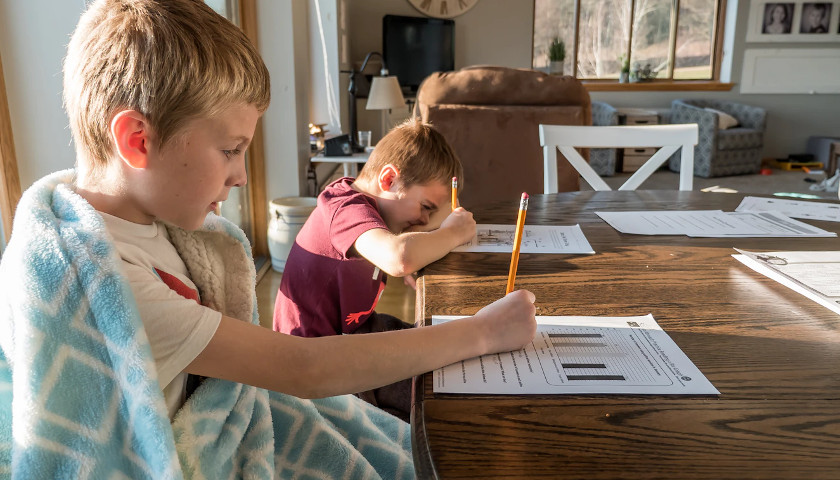by Jeff Minick
Though some students have found learning at home relieves them of school’s social stresses, many others miss their teachers, classmates, and the routine of the school day. Some of the little ones have become more defiant and have reverted to bed-wetting, while many older students suffer from depression.
In “The Children of Quarantine: What does a year of isolation and anxiety do to a developing brain?” Lisa Miller cites both statistical and anecdotal evidence to demonstrate that distance learning negatively affects the mental health of pre-K through 12th grade students.
Miller also addresses what our policy makers may have forgotten:
The kids who are suffering most in this pandemic are the kids who were already suffering most. Kids with intellectual or physical disabilities, for example, whose lives depend on reliable schedules or in-person care, are disconnected from their lifelines. In Fisher’s data, their emotional difficulties are at a peak. And there have always been children growing up in a desert of adult attention or for whom that attention was a threat. For these children, home may never have been a refuge, and they are not helped by Zoom.
Add to this legion the students who miss their friends, can’t participate in sports, drama, and musical events, and the many others who have simply given up on online learning, and we’re looking at millions of children deprived of their normal lives. The Americans least susceptible to COVID-19 are among those suffering the most under quarantine.
In addition to these psychological blows, many students are also learning less. “How did America’s remote-learning experiment really go?” presents the results of more than a dozen surveys conducted around the country during the spring and summer. Though some students, generally those in higher quality school districts, kept up with their schooling at home, many others either fell behind or quit attending class altogether. Poorer students or students in households where both parents had to work faced uphill battles in this transition.
Many schools have reopened their classrooms this fall. Here in Warren County, Virginia, for example, school administrators instituted a hybrid system in which students physically attend class certain days of the week and do the remainder of their work at home online. Students also have the option to take all of their classes at home. Extracurricular activities like football and drama are postponed until the spring.
Government officials, public health experts, and representatives of the teachers’ unions continue to debate the wisdom of these school closures. Last spring, when we knew so little about the virus, shuttered schools and distance learning appeared to make more sense, and officials were under tremendous pressure to take as safe a path as possible for all Americans.
Today, however, we know that young people are far less likely than the rest of us to suffer the effects of COVID-19, and in fact the virus may be less deadly than believed for the population at large. As a result, schools in places as diverse as China and Sweden are open and operating with guidelines in place to allow in-person instruction. Even Dr. Fauci is now encouraging a similar path, despite having condemned Sen. Rand Paul for suggesting children could safely return to school several months ago.
As Miller reports, a growing mountain of evidence reveals the hidden and often unreported damage done to young people by these shutdowns. The high school soccer player hoping for a college scholarship, the second grader who misses his friends, the freshman who is eager to try her hand at acting: millions of activities and plans are now on hold.
Some of our officials make much of rising COVID-19 case levels with the arrival of colder weather, and so advocate for even stronger measures to protect us from the virus. As a result, some schools that reopened this fall are once again closed. Presidential candidate Joe Biden is calling for even tighter restrictions: mandatory masks nationwide, more lockdowns, and probably more closed schools.
These people refuse to acknowledge that such measures have failed, that they have not measurably impacted the number of cases, and that COVID-19 will still be here when the masks finally come off.
Meanwhile, those epidemiologists and scientists who point out the futility of these draconian measures find themselves ignored by our news outlets or banned from social media. These people merely recommend that elderly people and those with underlying health conditions quarantine themselves, with the rest of us resuming our normal lives.
For young people, the cure for this pandemic has proven worse than the disease. The time has come when we must do our utmost to reopen schools and return students to their classrooms and playing fields, giving them back their lives.
– – –
Jeff Minick lives in Front Royal, Virginia, and may be found online at jeffminick.com. He is the author of two novels, Amanda Bell and Dust on Their Wings, and two works of non-fiction, Learning as I Go and Movies Make the Man.




